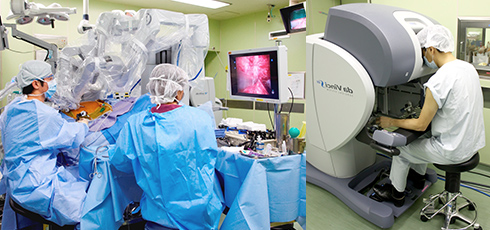
Kidney Cancer
1. Treatment Methods for Kidney Cancer depending on Progression
Radiation treatment and chemotherapy are not very efficient for kidney cancer, so the basic treatment is operative therapy. Our treatment principles are the following (the below are general, and actual treatment depends on age and conditions.)
| Stage | Treatment |
|---|---|
| T1a(The radius of the tumor is below 4cm) | Partial nephrectomy (laparotomy or laparoscopic surgery) |
| T1b(4cm<tumor radius≦7cm) | Total nephrectomy(laparoscopic surgery) |
| T2(Tumor radius is above 7cm but localized to the kidney) | Total nephrectomy(laparotomy or laparoscopic surgery) |
| T3(Perinephric fat tissue/pronephros/Progressed to the renal vein) | Total nephrectomy(laparotomy) |
| T4(T4(Direct invasion to the perirenal organs)) | Surgery if possible, treatment by medication |
2. Robot-assisted Laparoscopic Surgery
- The standard treatment for early stage kidney cancer under 4cm is partial nephrectomy.
The treatment results of partial nephrectomy and total nephrectomy for early stage kidney cancer are proved to be equivalent.
The partial nephrectomy allows the preservation of more kidney functions. Recently, studies show that the decline of kidney function not only affects the kidney itself but is a risk for heart and cerebral blood vessel diseases. Thus, partial nephrectomy that can preserve kidney functions has attracted attention. The Japanese and Western treatment guidelines for kidney cancer also recommend partial nephrectomy for early stage cancer. - The normal laparoscopic surgery is considered difficult because there is a limit to the movement of the forceps.
Partial nephrectomy can be conducted through laparotomy or laparoscopic surgery. The laparoscopic surgery is less invasive to the body, but since the tip of the forceps does not bend and there is a limit to the movement, the surgery was difficult. - The da Vinci robot-assisted surgery uses the advantages and overcomes the difficulties of the laparoscopic surgery.
The forceps used in this surgery have joints and can move like the human hand, so resections and saturation can be conducted easily at a free angle. Additionally, the surgery will be conducted under a 3D high resolution image, so a more delicate procedure is available.
*The robot-assisted laparoscopic surgery for kidney cancer is not covered by Japanese national health insurance. The applicable tumors are restricted by size and region. Please ask the Urology department for more details.
3. Medication used for Kidney Cancer Treatment
The main medications used for kidney cancer treatment are molecularly-targeted drugs and immunotherapeutic drugs.
- Molecularly-targeted Drugs
This is a type of anti-cancer drug that stops the progress of cancer by blocking the function of the intracellular matter that is necessary for cancer cell growth. - Immunotherapeutic Drugs
Immunotherapy here points to medication that has been scientifically proven to be effective by clinical investigation. More specifically, the names of these drugs are Interferon or Interleukin 2.
4. Radiofrequency Ablation Treatment
Radio waves are sent to the tumor through an inserted needle. The waves change into heat, which destroys the cells. The radical cure rate is lower compared to surgical treatment, but it is fit for patients inept to surgery and can be repeated by necessity. This treatment is for patients with a tumor smaller than 3 cm.
